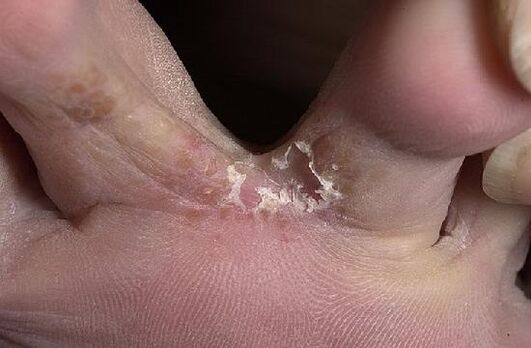A fifth of the European population suffers from mycosis of the legs. These are data from a study that was carried out in all European countries. The fungus on the feet most often starts with interdigital folds for the following reasons:
These are data from a study that was carried out in all European countries. The fungus on the feet most often starts with interdigital folds for the following reasons:
- Vascular diseases of the legs (21%);
- Obesity (17%);
- Leg pathology - narrow interdigital spaces, diabetic foot, flat feet (15%);
- Trauma to skin, nails and fingers from tight shoes, sports injuries, angular pedicures.
Favorite place of appearance of mycosis of the legs - the narrowest spaces between the 3, 4, 5 toes. From there, the fungus attacks all interdigital folds, the skin of the sole with side edges, the dorsum of the foot and the nails
How do you recognize mycosis of the foot? Toe fungus symptoms
- A crack or funnel appears between the toes, the edges of which are covered with whitish or greenish squamous epithelial membrane.
- The crack can weep with exudate;
- A circular diaper rash with peeling skin appears under and between the fingers (intertriginous symptoms);
- With the flow between the toes cleared, the cracks are barely noticeable, but the peeling takes on a flour-like character (the skin looks like it's sprinkled with flour - these are the affected scales). Symptoms are especially common in children;
- There is a slight itchiness between the fingers, but there is no major discomfort.
In a "dormant", cleared state, the fungus can remain indefinitely between the toes and hide symptoms. But the processes will grow. Gradually, the skin looks drier, rougher, rougher, more flaky, takes on a dirty yellow-gray color, horns to the point of calcification, cracks in particularly rough places.

Simultaneously or sequentially, the stage of onychomycosis occurs - nail lesions that change color, thicken, peel and crumble. They come to such an end in the later stages, when symptoms clearly indicate long-term health neglect.
The second path of development of the fungus between the fingers is less common (approx. 8%). This is a "wet", vesicular, or exudative fungus, in which vesicle vesicles burst and ulcers appear after them. Such wet mycosis between the toes affects people with severe stress, long walks, poor, tight, unventilated shoes, improper fungal therapy and self-treatment with antifungal and corticosteroids.
If you sabotage the treatment of the fungus between the toes, then 80-100% of patients will be affected by the toenails, 20% - on the hands. The look is sad and repulsive, the nail looks like crumbling dust or laundry soap. It can also take on the appearance of a "vulture's claw" or grow into it. And an ingrown toenail is a painful treatment, too.
How To Cure Interdigital Fungus?
Even if all of these symptoms appear after many years, you must start treating the fungus between your fingers immediately as it is a highly contagious and difficult to treat infection.
We go to the dermatologist. Before the treatment, he scratches his fingers and examines them using microscopy, culture or DNA analysis. Microscopy shows mycelial filaments or spores.
Systemic treatment consists of taking tablets or capsules with antifungal drugs. These accumulate in the horny tissue, penetrate through the blood and destroy the fungus for many weeks after taking the drug
The disadvantage is that systemic drugs are moderately hepatotoxic (they have a bad effect on a weak liver) and therefore the treatment cannot be used in people with diseased liver, pregnant women, breastfeeding women, young and old. The type of medication depends on the type of pathogen. When symptoms are unclear and the type is unknown, broad-spectrum drug treatment is prescribed. The use of systemic drugs is still a risk, in advanced stages they must be treated for a long time.
You can also treat with local drugs that are applied to the lesions. Such drugs often have a wide range of effects, killing both fungi and bacteria. Treatment is long and intense, so you should tell your doctor immediately if your resources are limited.
Home therapy and fungal infection prevention. There is no point in treating the fungus yourself. Information enables us to talk about its exceptional survivability and high recurring potential.
Prevention is an effective tool.
- Check family members for fungal symptoms. Intrafamily contamination is common. All must be treated;
- Do not use other people's shoes, socks, or pedicures, and do not wipe yourself with a shared towel.
- Not all fungi die even at 100 degrees Celsius, but a significant part - yes, so wash bedclothes and bathroom linen at 90 degrees;
- Disinfect shoes with antifungal spray once a month, bathroom surfaces once a week;
- Do not go barefoot in public places and do pedicures in well disinfected salons.
- For the prevention of fungus, you can use an antifungal ointment that is applied to clean and dry feet.
- Do not put on your shoes until your feet are dry.
Dermatologists also advise doing a pedicure at least once a month for a month and a half to remove dead tissue. The fungus likes to settle in them. Better to be careful than to heal later.
In the clinic, you can undergo an examination and advice from a dermatovenerologist.


















